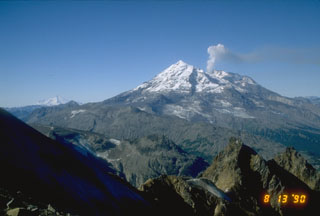Report on Redoubt (United States) — 18 March-24 March 2009
Smithsonian Institution / US Geological Survey
Weekly Volcanic Activity Report, 18 March-24 March 2009
Managing Editor: Sally Sennert.
Please cite this report as:
Global Volcanism Program, 2009. Report on Redoubt (United States) (Sennert, S, ed.). Weekly Volcanic Activity Report, 18 March-24 March 2009. Smithsonian Institution and US Geological Survey.
Redoubt
United States
60.485°N, 152.742°W; summit elev. 3108 m
All times are local (unless otherwise noted)
On 18 March, AVO lowered the Alert Level for Redoubt to Advisory and Aviation Color Code to Yellow because seismicity declined to levels recorded prior to the ash emission on 15 March. Seismicity remained low the next day. Shallow earthquake activity was noted again on 20 March. On 21 March, a steam plume rose to an altitude of 3.4 km (11,200 ft) a.s.l. Later that day, the rate of seismic events continued to increase, prompting AVO to raise the Alert Level to Watch and the Aviation Color Code to Orange. On 22 March, an explosive eruption began at 2238, prompting AVO to raise the Alert Level to Warning and the Aviation Color Code to Red, the highest levels. Four more explosive eruptions occurred, with each lasting between 4-30 minutes. Ash plumes rose to an altitude of 18.2 km (60,000 ft) a.s.l., with the bulk of the ash volume between 7.6-9.1 km (25,000-30,000 ft) a.s.l. Ashfall was reported in areas 190-250 km NE. The last explosion ended at 0500 on 23 March. No ash was detected afterwards utilizing radar data, suggesting that if ash emissions were occurring, plumes would be below approximately 4 km (13,000 ft) a.s.l. and/or contain particles too fine to be detected. Poor weather hindered visual observations of the volcano. The sixth explosion began on 23 March at 1941, lasted about 17 minutes, and produced an ash plume that rose to an altitude of 15.2 km (50,000 ft) a.s.l. and drifted W and N. Pyroclastic flows were visible traveling down the N flank in web camera images. According to news articles, Alaska Airlines cancelled 19 flights on 23 March due to ash plumes.
On 23 March, AVO staff visited areas around Redoubt and saw large lahar and flood deposits in the Drift River valley. The eruptions caused melting of the Drift Glacier and greatly increased discharge down the Drift River, causing lahars that traveled more than 35 km, reaching the Cook Inlet. In the middle to upper Drift River valley, high-water marks reached 6-8 m above the valley floor. At the AVO hut (roughly 11 km NNW of the summit), a 6-cm-thick fall deposit was observed. On 24 March, AVO reported that a steam plume rose to an altitude of 6.1 km (20,000 ft) and drifted about 65 km NW.
Geological Summary. Redoubt is a glacier-covered stratovolcano with a breached summit crater in Lake Clark National Park about 170 km SW of Anchorage. Next to Mount Spurr, Redoubt has been the most active Holocene volcano in the upper Cook Inlet. The volcano was constructed beginning about 890,000 years ago over Mesozoic granitic rocks of the Alaska-Aleutian Range batholith. Collapse of the summit 13,000-10,500 years ago produced a major debris avalanche that reached Cook Inlet. Holocene activity has included the emplacement of a large debris avalanche and clay-rich lahars that dammed Lake Crescent on the south side and reached Cook Inlet about 3,500 years ago. Eruptions during the past few centuries have affected only the Drift River drainage on the north. Historical eruptions have originated from a vent at the north end of the 1.8-km-wide breached summit crater. The 1989-90 eruption had severe economic impact on the Cook Inlet region and affected air traffic far beyond the volcano.
Sources: Associated Press, US Geological Survey Alaska Volcano Observatory (AVO)

